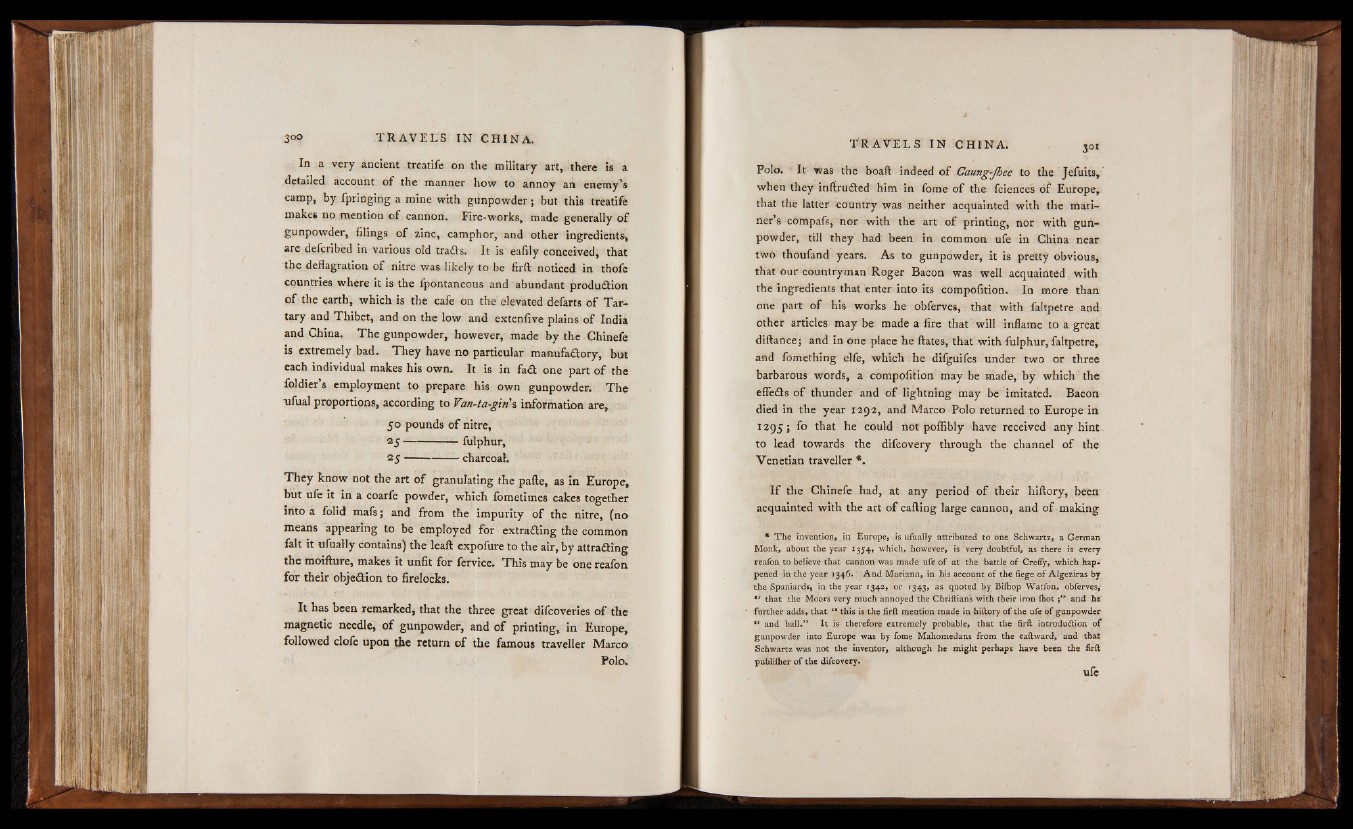
In a very ancient treatife on the military art, there is a
detailed account o f the manner how to annoy an enemy's
camp, by fpringing a mine with gunpowder; but this treatife
makes no mention o f cannon. Fire-works, made generally o f
gunpowder, filings o f zinc, camphor, and other ingredients*
are defcribed in various old traits. It is eafily conceived, that
the deflagration o f nitre was likely to be firft noticed in thofe
countries where it is the fpontaneous and abundant production
o f the earth, which is the cafe on the elevated defarts o f Tar-
tary and Thibet, and on the low and extenfive plains o f India
and China. The gunpowder, however, made by the Chinefe
is extremely bad. T h e y have no particular manufactory, but
each individual makes his own. It is in fa d one part o f the
foldier s employment to prepare his own gunpowder. T h e
tifual proportions, according to Vtn-ta-gin’s information are,
50 pounds o f nitre,
2 5 ------------ - fulphur,
2 5 -------------- charcoal.
T h e y know not the art o f granulating the pafte, as in Europe,
but ufe it in a coarfe powder, which lometimes cakes together
into a folid mafs; and from the impurity o f the nitre, (no
means appearing to be employed for extracting the common
fait it ufually contains) the leaft expofure to the air, by attracting
the moifture, makes it unfit for fervice. This may be one reafon
for their objection to firelocks.
It has been remarked, that the three great diicoveries o f the
magnetic needle, o f gunpowder, and o f printing, in Europe,
followed clofe upon the return o f the famous traveller Marco
Polo.
Polo. ' It was the boaft indeed o f Caung-Jhee to the Jefuits,
when they inftruCted him in fome o f the fciences o f Europe,
that the latter country was neither acquainted with the mariner’s
compafs, nor with the art o f printing, nor with gunpowder,
till they had been in common ufe in China near
two thoufand years. As to gunpowder, it is pretty obvious,
that our countryman Roger Bacon was well acquainted with
the ingredients that enter into its compofition. In more than
one part o f his works he obferves, that with faltpetre and
other articles may be made a fire that will inflame to a great
diftance; and in one place he ftates, that with fulphur, faltpetre,
and fomething elfe, which he difguifes under two or three
barbarous words, a compofition may be made, b y which the
effeCts o f thunder and o f lightning may be imitated. Bacon
died in the year 1292, and Marco Polo returned to Europe in
12 9 5 ; fo that he could not poffibly have received any hint-
to lead towards the difcovery through the channel o f the
Venetian traveller *.
I f the Chinefe had, at any period o f their hiftory, been
acquainted with the art o f calling large cannon, and o f making
* The invention, in Europe, is ufually attributed to one Schwartz, a German
Monk, about the year 1354, which, however, is very doubtful, as there is every
reafon to believe that cannon was made ufe of at the battle o f Crefly, which happened
in the year 1346. And Mariana, in his account o f the liege of-Algeziras by
the Spaniards, in the year 1342, or «343, as quoted by Biihop Watfon, obferves,
If that the Moors very much annoyed the Chriftians with their iron i h o t a n d he
further adds, that *• this is the firft mention made in hiftory o f the ufe o f gunpowder
and ball.” It is therefore extremely probable, that the firft introduction o f
gunpowder into Europe was by fome Mahomedans from the eaftward, and that
Schwartz was not the inventor, although he might perhaps have been the firft
publiiher o f the difcovery.